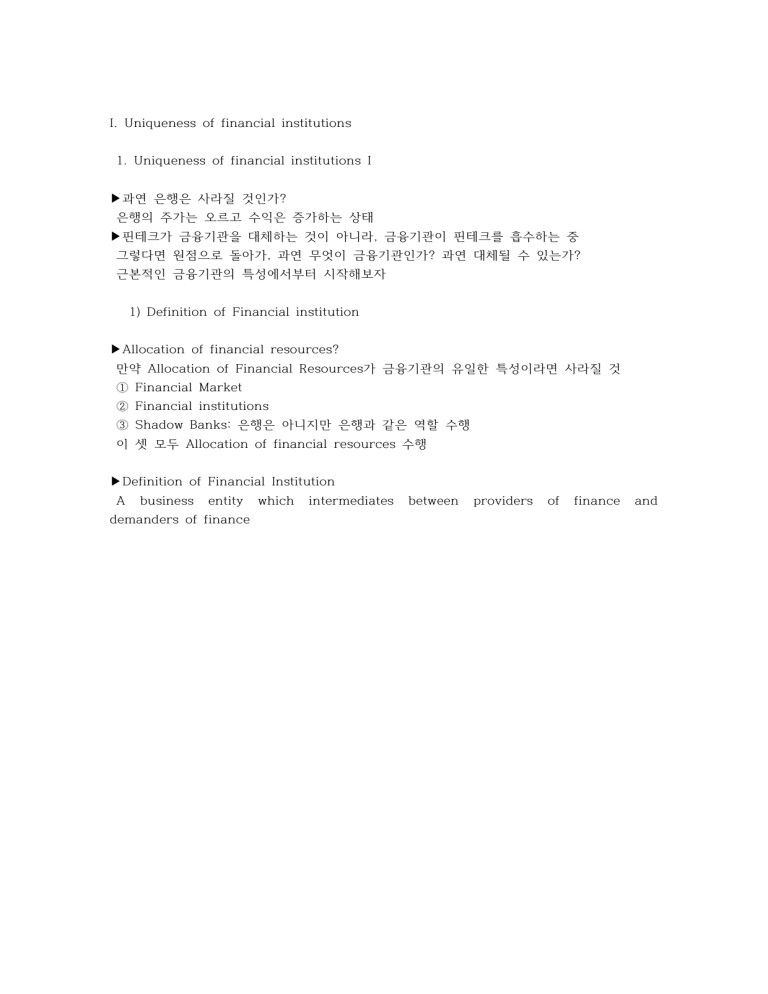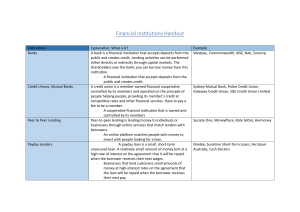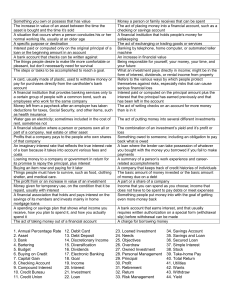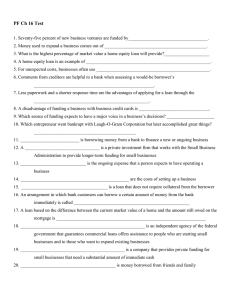
I. Uniqueness of financial institutions 1. Uniqueness of financial institutions I ▶과연 은행은 사라질 것인가? 은행의 주가는 오르고 수익은 증가하는 상태 ▶핀테크가 금융기관을 대체하는 것이 아니라, 금융기관이 핀테크를 흡수하는 중 그렇다면 원점으로 돌아가, 과연 무엇이 금융기관인가? 과연 대체될 수 있는가? 근본적인 금융기관의 특성에서부터 시작해보자 1) Definition of Financial institution ▶Allocation of financial resources? 만약 Allocation of Financial Resources가 금융기관의 유일한 특성이라면 사라질 것 ⓵ Financial Market ⓶ Financial institutions ⓷ Shadow Banks: 은행은 아니지만 은행과 같은 역할 수행 이 셋 모두 Allocation of financial resources 수행 ▶Definition of Financial Institution A business entity demanders of finance which intermediates between providers of finance and -Without FIs (Only financial markets), the economy will look like this: Household: Net providers, 수입을 모두 소비하지 않고 일정부분 미래 소비를 위해 저축 Equity & Debt는 illiquid asset, 반면 cash는 liquid asset ▶발생하는 문제: ⓵ 가구와 기업의 수요는 정반대 가구는 liquid asset 선호, 기업은 illiquid asset을 제공하고 싶어 함 기업은 자금의 안정적인 공급처를 원함 ⓶ Price Risk 가구가 기업으로부터 equity & debt를 cash로 구매 자신의 매도가격이 자산의 매입가격보다 낮아질 리스크에 해당 → 현금에 비해 큰 price risk → 기업이 원하는 만큼 현금을 제공하지 않는 모습 발생 ▶금융기관의 존재는 이러한 문제 해결 가능 ▶With With FIs, the economy will look like this: Deposits/Insurance Polices: Security created by FI 2) FIs’ Specialness ▶The first question we ask Why do we need financial intermediaries in an economy? What if an economy has only financial markets and no financial intermediary? ▶Financial institutions provide some unique services financial markets cannot duplicate. ▶FIs’s specialness There are transaction costs in households providing cash directly to corporations: Information costs, Less liquidity & Substantial price risk ▶Information cost from information asymmetry Information Cost: 기업에 대한 투자정보를 알고자 하려면 정보를 구매하여야 함 가구: 기업에 대한 정보 파악이 어려움, 개별 투자에 대한 정보 無 기업: 가구에 비해 용이한 정보파악 가구는 기업에 대한 정보를 알아야만 투자 가능 ▶Monitoring Cost: 기업이 내 돈으로 무얼 하는지 감시하는데 드는 비용 State Verification Cost: 지출에 대한 증명을 해 내는데 드는 비용 Information Acquisition Cost: 정보 구매에 드는 비용 ▶이러한 information cost가 크다면 기업에게 cash 제공 X ▶Without FIs: Low level of fund flows. 가구가 기업의 수요에 알맞은 cash 제공 X → FI의 존재는 이러한 비용들을 줄여주는 것 ▶Uniqueness of financial intermediation is to reduce all of these transaction costs and alleviate the failure of financial markets. -With FIs, the economy will look like this: ▶금융기관은 2가지 서비스 제공, Broker와 Asset Transformers ⓵ Broker Broker’s goal is to provide as favorable terms of transaction as possible for its customer. 정보와 거래서비스를 제공함으로써 저축자를 위한 대리인으로 행동 거래를 도와주는 역할, 수요자와 공급자 사이를 중개 이러한 효율성은 결과적으로 거래비용의 감소 또는 규모의 경제를 발생시킴 ⓶ Asset Transformer (자산 전환자) The process in which financial institutions convert secondary securities into primary securities. Secondary securities are short-term, liquid and have a low price risk compared with primary securities. 금융회사는 본원적 증권(주식, 채권, 기타 부채 청구권)을 매입하는데, 이 매입자금은 예금, 보험 및 기타 다양한 형태의 금융청구권을 가계부문과 시타 부문에 판매함으로써 조달 금융회사가 발생한 금융청구권은 기업이 발행하고 궁극적으로 실문자산에 투자되는 본원적 증권을 기초로 하기 때문에 2차 증권이라고 부름 저축자가 기업이 발생행한 증권에 직접 투자할 때 직면하는 비용을 금융회사가 보다 더 잘 해결 가능 (감시비용, 유동성 비용, 가격리스크) 가구는 liquid한 자산을 원하나, 기업은 illiquid한 자산을 제공하고 싶어 함 → FI는 illiquid한 자산을 liquid하게 바꿔주는 역할을 Assets Loans (Maturity high) Liabilities Deposits (Maturity Low) ▶Asset transformation is not free to FI Let’s think about the balance sheet of an FI after it performs asset transformation. FI holds primary securities in the asset side of the balance sheet and holds secondary securities in the liability side of the balance sheet. This means that FI is exposed to significant liquidity risk and interest rate risk. → Essential Outcome ▶은행의 이러한 역할에는 비용 발생 → Interest Rate Risk 발생 금리가 오르면 자산의 가치는 하락함 은행의 자산은 Loans and Deposits이고 만기가 길수록 가치의 하락폭은 커짐 즉, R↑ → Loan의 가치 하락 → Equity의 가치 하락 ∴ FI는 상당히 큰 리스크를 지고 있는 셈 ▶이 시점에 Asset Transformer 역할은 상당히 중요함 FI는 상당히 큰 Risk를 지고 있으며, 이러한 리스크를 관리하는 역할을 하고 있음 ▶이를 어떻게 감당하는가? By Economies of scale in Diversification, Diversification을 통해 리스크 관리 可能 ▶Liquidity and Price Risk Liquidity Risk: 자산의 유동성이 부족하여 대외지급에 문제가 생길 가능성, 고객의 자금인출 요구를 은행 등 금융기관이 즉시 응할 수 있느냐의 기준을 말함 Price Risk: 자신의 매도가격이 자산의 매입가격보다 낮아질 리스크 Secondary claims issued by FIs have less price risk FIs have advantage in diversifying risks 금융회사는 투자에 있어서 대수의 법칙을 활용할 수 있음, 리스크 분산을 통해서 가능 ▶Reduced transaction & information costs economies of scale in information acquisition 개별 가구가 database를 구매하기엔 너무나도 큰 비용 ▶Information Costs: Investors exposed to Agency Costs: Role of FI as Delegated Monitor (Diamond, 1984) FI likely to have informational advantage ▶5개의 가구가 각 $1씩 기업에 투자한다고 가정해 보자 해당 기업을 감시하는데 각 가구당 Monitoring Cost $0. 1필요 사실 한 가구만 감시해도 충분하나, Free-riding의 우려 존재, 한명만 하면 나머진 무임승차 5개 가구가 모두 감시하다면 $0.5의 비용 발생, $0.4는 사실상 낭비인 셈 → FI가 위임 감독으로서 기업을 Monitor, Monitoring Cost 절감 可能 ▶이런 맥락에서 FI가 지고 있는 상당한 Risk는 사회경제적으로 바람직한 것 개인에 비해 큰 규모와 Diversification을 통해 리스크 관리 可能 By: Risk Management Skill과 Low Information Cost를 통해서 (Major Force) ▶은행이 Risk에 대한 노출을 꺼린다면, 경제에 대한 긍정적인 효과 감소 실제로 은행은 리스크를 지기 싫어하지만, 정부의 지원은 risk를 지게끔 만듦 + 수익성 장려 ▶ex) 은행의 중소기업 대출 중단 은행 입장에선 위험이 큰 대출에 해당, 그러나 중소기업은 은행의 대출에 크게 의존 → 사회 전체적으로 바람직하지 못한 결과를 가져옴 ▶은행은 Risk를 짊어짐으로써 Uniqueness를 갖게 됨 -Other Special Services ⓵ Maturity intermediation ⓶ Transmission of monetary policy 중앙은행의 통화 정책에서 시중은행 또한 큰 역할을 수행함 ex) 통화량 증가 정책을 핀다면 시중은행으로 하여금 대출을 장려하게끔 initial cash는 $1이지만, 궁극적으로 deposit은 $2 → 또 다시 C에게 $1 대출 → 궁극적으로 deposit $3 → 무한 반복 시 통화량 무한 증가 ∴ 중앙은행은 Reserve Requirement제도 운영 시중은행은 예금을 받았을 때 일정 부분을 은행 금고에 보관하게끔 만듦 ex) Reserve Requirement 10% 최대 90%까지만 대출 가능, 위와 같이 꼬리를 계속 물면 대출 가능 규모는 축소될 것 → 중앙은행이 통화량을 늘리고자 하자면 reserve requierment를 낮추는 방향으로 수행 ⓷ Credit allocation (Areas of special need such as home mortgages). 특정 산업에 제공 ex) 농협, 정부의 소상공인을 위한 FI 창설 ⓸ Intergenerational transfers or time intermediation. ex) 생명보험 ⓹ Payment services ex) 수표, 단기금융투자신탁(Money Market Mutual Fund) ⓺ Denomination intermediation. 2. Uniqueness of financial institutions II ▶은행의 주요 서비스는 에금(Deposit)과 대출(Renting) Deposit taking and loan granting simultaneously 1) The nature of traditional banking ▶Banks tend to maintain long-term relationships with their customers. 길가다 현금이 필요하면 ATM서 출금, 다음날 또 필요할 때 해당 특정 ATM을 찾진 않음 일회성 거래에 해당 ▶Their businesses are relationship-based. 은행은 장기적인 관계를 추구, 관계지향적인 특성 有 ▶Among financial institutions which provide unique services to the economy, banks occupy a unique position in that they have a special ability to deal with informationally opaque customers. ▶Providers of fund와 demanders of fund 사이의 Information Asymmetry 존재 Information Asymmetry는 Adverse Selection과 Moral Hazards를 가져옴 → 이러한 문제들을 줄이기 위한 FI ▶Adverse Selection과 Moral Hazards Adverse Selection: Hidden Type, 빌리는 사람이 무슨 말을 해도 증명할 방법 低, 알기 難 Moral Hazards: Hidden Action -Banking Relationship (Petersen and Rajan 1994) ▶은행은 불투명한 Borrower와 Long=term Relationship 추구 Long-term Realtionship을 통해 soft information 추출 ex) 불투명한 borrower가 채권을 발행한다면 아무도 그 채권을 하려 하지 않을 것 은행 말곤 Soft Information이 없음 → Monopoly Rent, 정부는 은행의 high profit을 보장해 주고 있음 ▶Informational Monopoly를 통해 unique service를 제공하는 셈 불투명한 borrower에게 loan 제공이라는 unique service 이러한 독점은 사회 전체적으로 바람직한 것 *Soft information: 측정 不可 ex) 믿을만 함 Hart information: 측정 可能 ex) 키 180 일반적으로 soft information은 convey 難 ▶Bank loan is usually a more costly source of funds compared with corporate bond. Loan rate includes monopoly rents. Loan rate includes costs of maintaining buildings and hiring workers. Loan rate includes costs of regulation such as Basel Accord. ▶But, companies choose to obtain a majority of their external funds from banks not from financial markets. Why? 일반적으로 대출이자는 예금금리보다 높지만, 기업들은 은행에 크게 의존 ▶Advances in information technology make it possible that market participants can learn information about small firms which are previously informationally opaque. if) 은행의 Monopoly rent↓, Less incentive to provide unique services ▶Example: Credit information used to be available only to banks before the development in information technology. ▶This will weaken bank’s information monopoly and profitability of traditional narrow banking. -Where does the special ability of bank come from? ⓵ Long-term customer relationships ▶Borrowers abstain from opportunistic behavior to cheat their banks. ▶Banks learn about their borrowers through time. ▶Borrowers have more incentives to reveal true information. ⓶ Use of outside collateral (Asset owned by CEO ↔ Inside: Asset owned by firm) ▶A pledge of property or other assets that must be surrendered if the terms of bank loan contracts are not met. ▶Creditors offer a menu of contracts containing combinations (both) of interest rate and collateral as a risk sorting mechanism. 대출 담당자는 대출 요구자가 어떤 사람인지 알 수 없음 옵션을 제공함으로써 어떤 타입의 borrower인지 알아볼 수 있음 “Yes collateral & low r” vs. “No collateral & high r” → 이러한 매커니즘을 통해 Adverse Selection과 Moral Hazard 방지 가능 ▶Borrowers self-select contract and reveal their risk level ex ante. ▶By providing personal asset or wealth as collateral, one can prove oneself a good type of borrower ▶Bad type이라면, 파산(default)을 할 것이기에 outside collateral 제공 X option 1을 선택할 것 ▶Good Type은 자산이 파산하지 않을 것을 알기에 outside collateral 제공 → personal asset을 제공 시 borrower 자신이 good type임을 제시할 수 있음 파산 하지 않을 것이니까 내 자산을 담보로 잡아도 무관하기 때문 -Where does the special ability of commercial bank come from? ⓵ Cross-selling ▶Selling more than one financial product to the same customer 고객 A는 은행 B에 예금과 대출을 동시에 가지고 있음 → 은행 B는 고객 A의 cash flow 정보를 획득, Information Re-usage ▶Past information contained in checking accounts, savings accounts and previous loans provides valuable information to more easily determine credit worthiness (information reusability) 이러한 과거의 정보들을 통해, 빌려줄 금액과 금리 수준을 결정 가능 은행의 개별 고객 정보 ownership이 efficiency 창출 가능 ▶Why does bank hol on ownership of customer data? 고객 A가 대출을 받고자 한다면, A는 은행이 정보를 가짐으로써 benefit을 보게 됨 정보의 재활용이 Key, efficiency 창출 ⓶ Use of customized and detailed contractual terms ▶Compared with corporate bond contract which is usually boilerplate, bank loan contracts have detailed and customized contractual terms. 은행 대출은 정해진 서류를 채우는 것이 아니라 개별 규정을 명시한 계약서를 작성 ▶Why? Since the debt ownership of a bank loan is concentrated, renegotiation costs are lower with a bank loan when a borrower defaults. Therefore, ex ante, creditors can afford detailed loan contracts. ▶은행 대출은 은행만이 가능하니 creditor의 수가 적음 채무자가 파산시 은행의 경운 파산을 forgive하고 협상 시작 위반사항이 있었으나 갚을 능력이 있어 보인다면 용서 (Optimal solution) BUT 변제 능력이 없어 보인다면 liquidate assets → 재협상 가능, 은행과 채무가가 재협상을 통해 optimal한 결과 추구 → tight, customized contract ▶반면에 Bonds: Too many creditors, 일일이 borrower를 만나 재협상 不可 봐주는게 optimal할 수 있지만, 일일이 확인하기엔 너무나도 큰 비용 그냥 liquidate → very loose한 contract ⓷ Superior credit evaluation skill -What is Lending? ▶Lending: Purchase of an asset (the borrower’s indebtedness) that is typically an illiquid and highly customized financial claim against the borrower’s future cash flows. ▶Differences between bank loans and other financial securities ⓵ Illiquidity – usually held until the maturity Feature of bank loan이나 최근 liquid해 지는 경향 有 ⓶ Highly customized to the current bank and borrower (Bank loans are private debts.) 재협상을 통한 optimal result 성취 可能 Bank Loan이 highly customized되지 않으면 다른 security와 다를 바 없음 ⓷ Complex and restrictive loan contracts compared to public debts such as corporate bond – due to the concentrated debt ownership ⓸ Flexibilities in the application of the loan contract terms – due to the concentrated debt ownership ex) If a borrower is temporarily undergoing problem, bank could lower interest rate. 이후에 상황이 좋아지면 높은 이자는 지불하는 방식으로 -Debt Ownership ▶Diffuse → Public debt → Renegotiation Cost 상승 Concentrated → Pricate Debt → Renegotiation Cost 하락 ▶Case1: Borrowers default caused by some non-recurring events (외재적 요인) forgive or even reduce debt amount ▶Case2: borrower’s financial health or inefficient management, etc (내재적 요인) → forgive 보다는 liquidate ▶Renegotiation Fee가 KEY Fee가 적다면 renegotiation을 통해 optimal solution ex) 수많은 creditor라면 이들 모두와 re=negotiate하기엔 너무나도 큰 비용 renegotiation fee가 낮다면 borrower’s default not costly to creditors -How this course is structured from now on – Balance Sheet of a Bank ▶Bank is Highly Leveraged. Capital에 의존 低 Deposit에 크게 의존하기 때문 예금주에겐 자산이지만, 은행에게는 부채에 해당. 반대로 대출은 은행에게 자산에 해당(채권) ▶Deposit ⓵ liquid: deposit의 maturity는 infinitesimal, 0에 수렴함 → continuously rolled over ⓶ no price risk: 주식의 경우 계속 가격이 변동, 반면 예금은 그딴 거 없음 ⓷ payment service: ex) 수표 ▶BUT, Deposit is a stable source of funds. Liquid한 deposit은 언제든지 돈을 뺄 수 있음 그렇다면 deposit state가 변화하는가? 그건 아님, 의외로 deposit size는 stable ▶이유는 customers & small firms는 Less sensitive to interest rate ▶BANK is highly leveraged Bank Manager has an incentive to take high risk 자산대체 효과가 이 뒤에 있음 (Asset Substitution Effect) ▶은행이 unique service를 제공하며 너무나도 큰 high risk를 가지는 것은 위험함 → 이를 capital(지본)을 통해 보완 (정부의 강력한 measure) ▶OBS Risk B/S에 기록될 수 없는 항목 존재 ex) 미래 가치에 기반한 자산 가치 (결정되지 않는 가치) 이 경우 foot note, 주석에 공시함 (각주거래 or 부외거래) -Asset Substitution Effect ▶기업이 저위험 투자를 고위험 투자로 바꾸는 것 ▶Stockholders: Limited Liability 회사의 주인인 주주는 주식의 시장가격이 오르면 이득을 보는 구조 따라서 기업은 주주를 만족시키기 위해 보다 위험한 자산에 투자하려는 경향을 보임 ▶그러나 채권자들의 경우 고정된 이율에 따라 이자를 받음 즉, 주식 가격이 오르건 말건 채권자들은 고정된 금액만을 받게 됨 그러나 위험한 자산에 투자하는 것은 그만큼 파산의 위험도 커진다는 것을 의미함 즉, 채권자들의 입장에선 파산의 위험은 커졌으나, 고정된 이율로만 지급받으니 아무런 추가 이익 없이 손해만을 보는 셈 반대로 주주들은 더 높은 수익을 얻을 수 있는 가능성이 생김 ▶1%가 Equity, 99%가 debt라고 해보자 leverage는 높고, 주주는 fund little Asset Substitution effect는 엄청나게 큼 → Convertible Debt가 해결책 ▶따라서 Equity가 FI 규제의 핵심이 되어야 함 주주가 채권자(일반 예금주들)의 돈을 빼먹는 셈 은행이 highly leveraged기 때문에 manager는 더더욱 대출을 많이 해줘야 함 이는 convertible debt로 dilute 함으로써 해결 가능함 2) Why has traditional banking been shrinking? -Decomposition of Lending (Originate-to-hold model) ▶Lending transaction is a bundle of following distinct services relating to credit transactions. Shadow Bank와 P2P Bank가 이 기존의 은행과 FI를 대체 가능할 것인가? 대체하려면 이 5가지 프로세스를 모두 duplicate해야 하나, 따라하지 못함, 몇 요소 부족 ⓵ Origination (the broker): The Role of underwriter(인수인) The activities of initiating a loan to a borrower: Solicitation of customer’s business, Loan application, Credit analysis, Design of loan contract including pricing, etc 돈을 빌려줄지 말지를 결정 ex) 법적 계학서 작성, 광고 등 ⓶ Funding (the lender) The actual extension of the loan after an affirmative decision is reached in the credit analysis 돈이 신청자에게 넘어가는 단계 → Outsource to shadow banks ⓷ Servicing (the collector) Collecting loan repayments and keeping records Bookkeeping & Collection of loan payments ⓸ Risk Processing (the guarantor) Post-lending monitoring to control default risk Diversification to control default risk Loan workouts to control default risk Control of interest rate risk ⓹ Credit Culture The bank’s organizational design, reporting practices and incentive schemes for credit officers Organizational design Reporting arrangements Communication practices Incentive schemes for credit officers arrangements, communication -예시 ▶가수가 로열티 수익을 받는 상황에서 스포츠카를 구매한다고 가정해 보자 현재 돈은 없지만 미래에 들어올 loyalty income은 분명 존재함 실현되기 이전의 이익이지만, 가수가 이를 팔고 은행이 구매함으로써 가능 → “Securitization” ▶은행은 Loan asset을 만기까지 가지고 있었으나, 최근 securitize하는 경향 有 이러한 loan asset은 asset backed security에 해당 투자자들은 loan asset을 구매 (Loan sale) ▶이 경우 은행의 역할이 사라지는 셈 채무자가 파산하더라도 손해 보는 것은 은행이 아니라 투자자나 다른 FI 은행은 그저 originating fee만 받으면 그만, 파산 여부는 관심 밖이 됨 ▶은행이 loan을 판매하는 이유 중 하난 maturity gap을 줄이기 위한 것 Asset인 loan은 일반적으로 만기가 긴 편에 속함 그러나 liability인 deposit은 상당히 짧은 만기 ▶Asset에 해당하는 loan의 만기가 100년이라 해 보자, 은행은 (1) Loan Sale: 전통적인 방법, 다른 은행이나 투자자에게 판매 (2) Securitize -What is lending? ▶Loan sale or securitization remove funding from other components of lending. ▶Large banks become more like loan brokers rather than traditional lenders. 과거 모델: Originate-to-hold model, loan을 만기까지 보유 현재 모델: Originate-to-distribute model, loan을 다른 FI나 투자자들에게 판매 Focusing on originating is highly profitable ▶Lending becomes a transaction-based business rather than a relationship-based business. Banks don’t earn interest income from long-term lending relationships but earn fee incomes when they originate loans. Some financial institutions passively hold loan shares to earn returns on their investment like corporate bondholders. ▶Small banks still maintain close long-term relationships with their customers and show strong competitive advantages in granting consumer loans. ▶Relationship based인 이유는 long-term relationship이기 때문 originate 후 판매에 관심을 보인다면 그저 transaction base에 불과 -Information asymmetry and lending ▶If there is no information problem in loan, there might not be any profit for banks in lending. 1) Otherwise, no need for banks and other financial intermediaries. 2) Costly borrower-specific information provides an opportunity for banks to profitably process information and facilitate lending. ▶The less transparent is the credit information about a given borrower, the greater is the bank’s ability to utilize its uniqueness and the higher is the profit potential. ▶Pre-contract adverse selection problem and post-contract moral hazard problem should be reflected in the lending decision. ▶Pre-contract adverse selection problem Screening, credit analysis Loan pricing reflects risk premiums that incorporate borrower’s credit quality perceived by the bank and the value of collateral backing the loan. The role of collateral ▶Post-contract moral hazard problem Monitoring Loan contract design (interest rate buildup, covenants) (1) Glass-Steagall Act and the prosperity of traditional narrow banking ▶Narrow banking used to be very easy and profitable! Narrow banking had been profitable by the 1960s. ▶Glass-Steagall Act prohibited commercial banks from engaging in investment banking Government provided an explicit guarantee for deposits (deposit insurance fund) Commercial banks provided unique services. Glass-Steagall Act prohibited investment banks from engaging in commercial banking (entry barrier). 상업은행으로 하여금 오직 예금 수취와 대출만을 허용하였음 ▶However, commercial banking environment started changing since the 1970s and the profitability of commercial banking started deteriorating since the 1970s. (2) Factors which deteriorated the profitability of traditional banking ⓵ Deposit side factors ▶Deposit: high liquidity, low price risk and payment services Money market mutual fund provides the same services only with higher returns. Since the 1970s, money market mutual fund has replaced deposits, shrinking the importance of deposits in the economy. Pension funds and investment companies help households to directly access the financial markets (disintermediation phenomenon) ▶과거엔 예금과 대출 금리차가이 커서 굳이 deposit과 lending 말고 다른 걸 할 동인 低 과거 예금 금리가 낮았던 이유는 unique service였기 때문 Money Market Mutual Fund의 등장 이전엔 depsit만이 유일한 제공처 그러나 현재 은행이 돈을 빼서 MMMF 구매, 은행의 unique service dilute → 은행의 금리 인상 & 전통적 서비스 외의 다른 사업을 찾게 됨 ⓶ Lending side factors ▶Loans: superior ability to deal with information asymmetry, monitoring Advances in IT allows financial market participants and non-bank financial institutions to access proprietary information about the borrowers. New securities are created to reduce issuer’s moral hazard problem due to the development in the financial technique. (Convertible bond is known to reduce a specific type of managerial moral hazard, that is, asset substitution effect.) Commercial paper market(기업어음) has developed drastically, so that firms rely more and more on commercial paper market for the external financing. ▶It is well known that bank loans and commercial papers are substitute for each other. ▶Commercial papers are short-term debts. So, as firms heavily rely on commercial paper for financing, they are exposed to high roll-over risk. ▶As long as deposits and loans provided unique services, narrow banking was profitable. Low (almost zero) deposit rate makes low cost of funds to banks, which gives banks cost competitive advantage. As long as deposits and loans provided unique services, commercial banks have no incentive to expand their businesses to non-bank security-related areas. Banks deviated from traditional narrow banking as uniqueness of deposits and loans was diluted. ⓷ Regulator side factors ▶Regulatory changes also led to shrinking narrow banking. Basel Accord defines any loan to be risky asset, so that banks should increase their equity capital when they grant loans Deposit insurance premium has been increasing. ▶ Led to increased regulatory cost ex) 바젤협약: 은행이 더 많은 capital을 보유하도록 함 as deposit insuance premium ▶Resulting in disintermediation reducing the supply of funds through the banking system →Consequently money left FI 3) Uniqueness of financial institutions and regulation of financial institutions ▶FIs receive special regulatory attention FI의 실패는 너무나도 큰 Adverse effect를 가져오기에 정부의 규제 必 ▶Negative externalities arise if these services are not provided. 은행이 망한다면 예금주, 직원, 주주들에게 직접적으로 악영향을 미침 그러나 추가적으로 무관한 제3자에게도 악영향을 미침 ex) 미래 그 은행에서 돈을 빌릴 수도 있는 중소기업, 미래 그 은행에 예금할 가구 → 정부의 개입이 필요함 ▶Reasons: Special services provided by FIs in general. Institution-specific functions such as money supply transmission (banks), credit allocation (thrifts, farm banks), payment services (banks, thrifts), etc. ▶Important features of regulatory policy: Protect ultimate sources and users of savings. Including prevention of unfair practices such as discriminatory actions. Primary role: Ensure soundness of the system as a whole. ▶Regulation is not costless, 분명 비용을 발생시킴 Net regulatory burden = regulatory benefit - regulatory cost ▶6가지로 유형화 가능 redlining and other (1) Safety and soundness regulation ▶규제가 가장 강한 산업은 은행과 상하수도 산업 ▶Regulations to increase diversification 한 채무자에게 일종 비용 이상 빌려주면 안됨 ex) 100% 삼전에게 대출 不可 ▶Minimum capital requirements 바젤협약, 경제적 이론의 토대 有 ▶Guaranty funds: FDIC: Bank Insurance Fund (BIF), Savings Association Insurance Fund (SAIF) Securities Investors Protection Fund (SIPC) Guarantee funds는 signaling effect. 은행은 실제로 문제가 없더라도 고객들의 psychology에 좌우되기 하기도 함 ▶Monitoring and surveillance government agency is monitoring Bank managers’ behavior (2) Monetary policy regulation ▶Federal Reserve directly controls outside money. ▶Bulk of money supply is inside money (deposits). ▶Transmission of monetary policy is “the process by which central bank’s monetary policy affects asset prices and the behavior of other economic variables, general economic conditions etc.” ▶Banks play an important role in this transmission of monetary policy 중앙은행뿐만 아니라 시중은행도 중요한 역할을 수행함 ▶Reserve requirements facilitate transmission of monetary policy. (3) Credit allocation regulation ▶Supports socially important sectors such as housing and farming. Requirements for minimum amounts of assets in a particular sector or maximum interest rates or fees. Qualified Thrift Lender Test (QTL): 65 percent of assets in residential mortgages Usury laws: ex) 고리대금 방지법, maximum limit ▶ex) 농협: provides credists directly to agricultural sectors (4) Consumer protection regulation ▶여기서 consumer는 loan applicant ▶Laws forbidding unfair lending practices such as redlining 인종이나 직업을 이유로 부당하게 대출을 거절하는 경우 ▶Community Reinvestment Act (CRA). 인정이나 민족, 혹은 수입에 의해 차별받지 않고 공동체에 필요한 자금 제공 그러나 이는 서브프라임 모기지 사태의 원인으로 지목되었음 저임금의 가족에게 대출을 해주게끔 은행에 강제 ▶Home Mortgage Disclosure Act (HMDA). ▶Effect on net regulatory burden FFIEC processed info on as many as 31 million mortgage transactions Huge burden on government agencies (5) Investor protection regulation ▶여기서 investor는 FI의 investor ▶Protections against abuses such as insider trading, lack of disclosure, malfeasance, breach of fiduciary responsibility. ▶Key legislation Securities Acts of 1933, 1934. Investment Company Act of 1940. (6) Entry regulation ▶Bank managers have an incentive to take excessive risk in their management decisions. One way to reduce this risk-taking incentive of bank managers is to reduce the competition in the banking industry. ▶Level of entry impediments affects profitability and value of charter. ▶Regulations define scope of permitted activities. ▶Affects charter value and size of net regulatory burden. ▶Charter value: the present value of its future economic profits as a going concern 은행이 수익을 많이 내지 못한다면? → Charter value가 낮음 → 은행이 지금 망하나 지금 망하나 무관 → high-risk-high-return 상품에 관심 정부는 이러한 현상을 원하지 않음 ▶따라서 정부는 FI가 상당히 높은 chart value를 유지할 수 있게끔 함 따라서 entry regulation은 Charter Value를 늘려주는 셈




